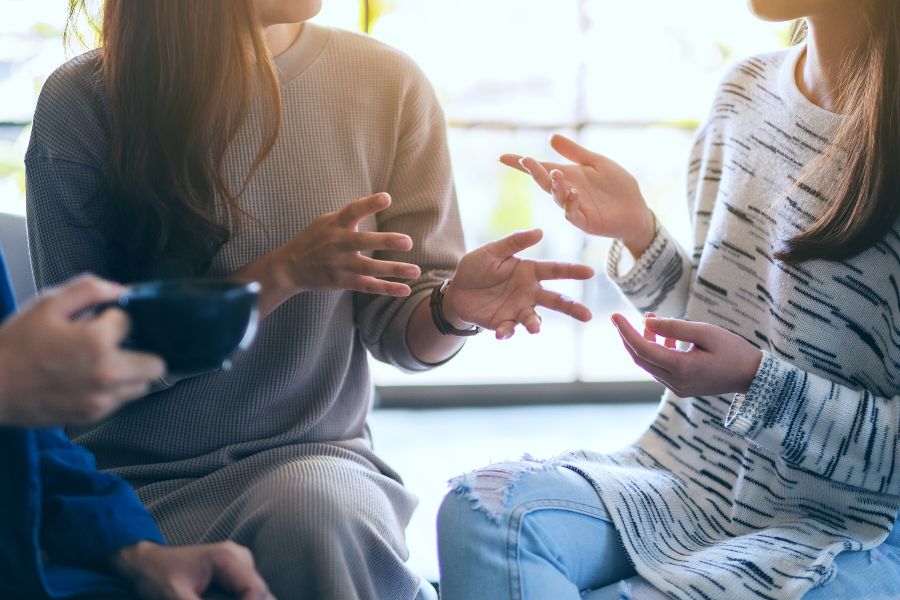It’s a familiar feeling, and it often goes like this:
You step into a grocery store or any store to shop for a weighted blanket, and a chain of thoughts bombards you. “Why is it so crowded?” “Will I get what I need?” Before you know it, the urge to leave gets stronger until you give in.
If this scenario describes you, you are dealing with grocery store anxiety.
While shopping can be a joy for some, it’s a source of severe anxiety for others. And while it’s normal to feel a little uneasy when deciding between several items or spending money, shopping anxiety can be pretty hard to manage.
But don’t worry; there are strategies for managing shopping anxiety disorder.
In this article, we’ll provide simple tips and advice to boost your self-esteem whenever you feel anxious during grocery shopping.
What Is Shopping Anxiety?
Have you ever felt nauseous when entering your favorite stores or grocery stores? Or become overwhelmed with the choices offered? If you answered yes to those questions, you may be experiencing shopping anxiety.
Shopping anxiety is a type of social phobia in certain situations, such as when shopping for clothing or groceries.
You may fear being judged by those around you or be embarrassed by not finding the right style or size. Sometimes, it’s triggered by the fear of spending too much or buying unimportant things. And it doesn’t have to be in-person shopping; online shopping can also induce anxiety!

Regardless of the cause, it would help to recognize that shopping anxiety is natural, and some strategies can help manage it.
Keep reading to find out more!
What Is Compulsive Shopping?
This is quite the opposite of feeling anxious while shopping. Compulsive buying happens when you are urged to keep shopping even when you know you don’t need anything. Or maybe you have trouble making decisions. And are stuck in a cycle of never feeling satisfied or content with your purchases.
These are classic signs of impulse buying, a disorder characterized by repeated and frequent purchases even when you don’t have enough money.
Compulsive shopping is a sub-category of anxiety disorders that, if left unchecked, can lead to more severe financial stress. It can also take away from other aspects of your life, like spending time with loved ones or pursuing hobbies that bring joy.
Here are three tips for managing compulsive shopping:
- Develop an awareness of what triggers your compulsive behavior – this could be boredom, stress, or sadness;
- Set boundaries for yourself when it comes to shopping – for example, determine a budget and stick to it;
- Find healthier coping mechanisms – such as exercising or meditating – instead of turning to shopping as an emotional outlet.
How to Manage Shopping Anxiety
Make a List and Stick To It

When dealing with shopping anxiety, the best strategy is to make a list and stick to it. This will give you structure and focus while shopping and reduce decision fatigue.
What is decision fatigue?
Decision fatigue happens when your brain gets overloaded by too many decisions, leading to mental exhaustion. As you may have guessed, it may cause or worsen shopping anxiety.
A post published by the American Psychological Association suggests that when people are given too many choices, they become overwhelmed.
By making a list of what you need and sticking to it, you reduce the number of choices you need to make while shopping.
Making a list can also give your brain time to process information and sort through possible options before heading out the door.
Ensure your list includes items within your budget so that when faced with enticing extras, you know precisely how much money you have available for spending.
Shop During Non-peak Hours
Another tip is to shop during off-peak hours. When you have anxiety resulting from social anxiety or sensory overload, it’s best to avoid the shopping crowd. So, don’t shop on the busiest days, like Saturday afternoon when stores are packed with people. It’s much easier to focus and stay calm when you don’t have many people surrounding you.
Aim for days and times that tend to be less crowded at most stores—like early morning weekdays or late evening weeknights—for a more stress-free shopping experience.
Also, many retailers offer different hours for seniors or those with disabilities who may not feel comfortable shopping during peak times due to larger crowds. Look online to see if your local store offers any special hours that could work best for you.
Don’t Feel Pressure to Make Big Purchases
When shopping, it’s easy to feel like you have to make big purchases. That pressure can be overwhelming and lead to anxiety. But it doesn’t have to be that way!
Instead of feeling pressure to make big purchases, why not start small? You don’t need to buy the most oversized item or the newest trend to feel satisfied. Breaking down your shopping goals into smaller steps lifts some pressure.
When you experience anxiety because you dread big purchases consider doing the following:
- Set a budget for yourself before shopping and stick with it.
- Keep a list of items you need and prioritize those over any impulse buys that may catch your eye.
- Shop with a friend who keeps you on track by reminding you of your budget.
- Start with one item at a time—you don’t have to fill up your basket all at once!
- Don’t be afraid to walk away if something doesn’t feel right; there’s no rush when shopping, so take your time!
Don’t Suffer in Silence

If all else fails, don’t be afraid to ask for help. It often feels like you’re facing the situation alone, and nobody else can understand what you’re going through, but some people can assist.
Whether it’s a family member, friend, or a mental health professional, talking to someone about your anxiety can help you figure out coping strategies. Having a support system makes it less scary and more at ease.
Know When to Call It a Day
Sometimes when you have panic attacks while shopping, it’s just best to call it a day. Taking breaks allows you to recenter and regroup.
Here are some tips for taking a break after a panic attack:
- Take a few deep breaths to help lower your heart rate.
- Make sure you stay hydrated by drinking plenty of water throughout the day.
- Set realistic goals and only focus on what you can accomplish that day.
- Make time for relaxing activities like yoga, meditation, or reading a book.
- Talk to someone close to you, like an understanding family member or friend, about how you’re feeling—talking it out can be helpful!
- If all else fails, simply step away from the stores or online shopping sites for the day. And take some time before returning another time to pick up where you left off!
In A Nutshell
Shopping anxiety is a real issue that impacts our physical and mental health. It’s crucial to recognize the signs, and you can overcome them. From taking breaks to enlisting the help of a buddy, there are many simple strategies you can implement for managing shopping anxiety.
Just pay attention to the simple tips above for a better shopping experience.



